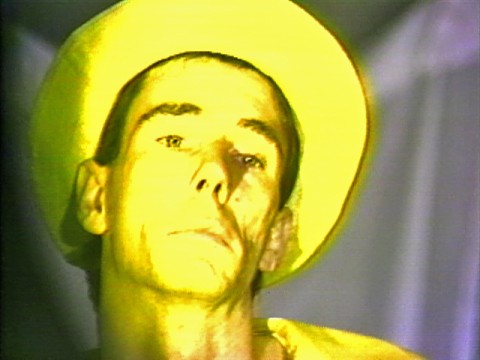Mike Kelley was born and raised in Detroit, Mich., in 1954. He received a B.F.A. from the University of Michigan at Ann Arbor and an M.F.A. from the California Institute of the Arts. He lives and works in Los Angeles, where he has influenced an arts community with a body of work that is highly diverse in terms of medium, subject matter, and stylistic approach. Kelley's drawings, sculptures, videos, performances, and installations subvert the conventional boundaries of high- and low-brow art and culture. He employs irreverent humor and devalued vernacular expressions to challenge the tastes and values of the art establishment. His Catholic, working-class upbringing extends his provocations to other realms of culture as well. Kelley consistently attacks various forms of authority and rejects traditional attitudes toward gender, sexuality, childhood, education, religion, consumerism, and even bodily functions.
Kelley often utilizes nontraditional yet familiar sources and materials—toys, crafts, and comics—to address these topics in his artwork, thus revealing their multilayered associations and upsetting nostalgic or conventional notions of both the objects and subject matter. The worn, grubby stuffed animals he assembled on an afghan in his celebrated wall hanging _More Love Hours Than Can Ever Be Repaid_ (1987) or the ones he placed on and under blankets in suggestive positions in his _Arena_ floor pieces (1990) sidestep references to childhood innocence or memories. Rather than allusions to the past, Kelley presents the toys as soiled, discarded debris of the present. He thereby dissociates the toys from children and reframes them as sullied objects or fantasies manufactured by adults.
The subversion embodied by various glam, punk, avant-garde, and psychedelic rock and jazz musicians were also instrumental in the development of Kelley’s artistic practice. His art stems from his longtime passion for the music of transgressive figures, such as Iggy Pop, Alice Cooper, and Jimi Hendrix. Kelley was also once a member of the experimental rock group Destroy All Monsters, and he collaborated with the noise rock band Sonic Youth on their album, _Plato's Cave_ (1986), to produce a performance piece in which he ranted about sexual and social freedom, and attacked the veneration of art, history, and patriotism. Nonetheless, while critics often view his work as abject art that espouses failure and bad taste, Kelley actually embraces reality. He calls attention to unacknowledged aspects of everyday life and demystifies sociocultural beliefs and traditions. Rather than the typical pristine imagery of the art world, church, advertising, and so on, Kelley's views of the world are more varied.
His alternative, multifaceted approach is on view in _The Banana Man_ (1983), Kelley’s first complete video work, which he created when he was primarily engaged with performance. Throughout the 28-minute video, Kelley wears a bright yellow sailor suit to perform as the Banana Man in various scenarios during which he also narrates. The text of his voice-over constructs a psychology of humor, misery, and confusion for Kelley’s Banana Man, as light-hearted word plays evolve into allusions to religious subjection, sexual perversion, and emotional manipulation.
In _The Banana Man_, Kelley tests the problem of characterization and uses his own imagination to find meaning in the unknown. He derived the title from a marginal character on the children's television show _Captain Kangaroo_. Having never had the chance to see the Banana Man, Kelley received all of his information about the character from the hearsay of childhood jokes and discussions. To his uncertainty about this already fictional personality, Kelley added his interest in the viewer’s impulse to read filmed characters as unified despite the disparate moments, limited details, and continuous jump cuts of an edited video. He thus combined a series of scenes about the Banana Man and left it to the viewer to resolve a puzzle of imagery presumably similar to Kelley’s childhood imaginings. Like much of Kelley's art, _The Banana Man_ suggests there are aspects to one's culture, psychology, and experiences that might not be desired or understood, but that could nonetheless be acknowledged and contemplated. _—Kanitra Fletcher_

